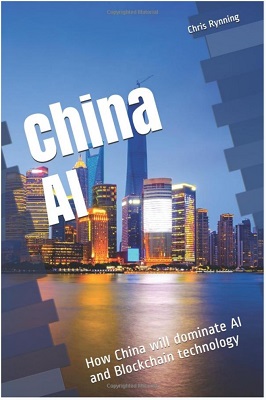
Chris Rynning’s book on AI in China reveals his deep understanding of the country, culture, and economics of the region. A Norwegian by birth and a graduate of the famous ESSEC in Paris followed up by an MBA from Chicago, Rynning lived and worked in Tokyo and Beijing for over 20 years before settling down (if someone like Rynning ever settles down) in beautiful Tiburon, California. Chairman of the nHack Nordic VC fund, he has seen all sorts of new technology, business plans, and people, and has gained a unique perspective of the engine of commerce in three dramatically difference societies, the Social democracies of Scandinavia, the communist society of China, and the capitalist societies of Japan and U.S. That’s a pretty unusual and special level of experience. Therefore, with that background, it is not surprising that he could, or would write such a book—who better qualified to do it?
After a short and easy to digest explanation of what AI is, Rynning lays out some foundation facts about China. In just 10 years, it leapfrogged the U.S. to number one in supercomputers, several years running, captured 42% market share of eCommerce worldwide, easily and quickly built multiple mega projects such as high-speed rail, three Gorges hydroelectric dam, the belt and road plan, and giant ultra-modern cities like Shenzhen.
But commitment, a vision of the future, enormous sums of money, and distinctly different vision of the future is where China will truly shine.
Unlike the U.S. that is currently stuck in a perverse self-destructive desire to look back and thinks things like dirty factory and mining jobs were just great, China is looking at the future and developing AI to get them out of manufacturing, digging, and dirty dangerous work. China doesn’t fear robotics and AI, China embraces it as being liberating. The country is rapidly shipping manufacturing jobs to Africa, southeast Asia, and South America. Says Rynning, “If Africa and Michigan would like to manufacture and ’be great again’ that is their choice. That era is over in tech-driven China. The ’China dream’ is to replace labor with advanced and innovative technology.” I can remember when that was our dream in the U.S.
And China can pretty much do it on their own. What they don’t have in software or technology today they can easily buy and license, and ultimately improve on. China also won’t need outside markets much longer. The ridiculous and ill-advised trade war is forcing China to look inward for growth. With a home market of 1.3 billion people, more than the U.S., Europe, and Japan combined, China can keep itself busy and profitable just satisfying the Chinese demand.
And they will do that with the aid of AI.
AI is predicted to contribute $15.7 trillion to global GDP by 2030—and China will account for $7 trillion of it, compared to $3.7 trillion in the U.S.
Find out how they will do that, why they will do that and what the U.S. could learn (if the U.S. were capable of learning anything anymore) from the Chinese model.
Rynning’s book is ridiculously affordable (I’ve counseled him to quadruple the price, but he’s still Norwegian and they didn’t get a very good helping of the greedy gene). I sent copies to several of my friends, suggest you do the same.
it is available for US$6 in paperback here (and $2.50 in Kindle version): China AI on Amazon.






